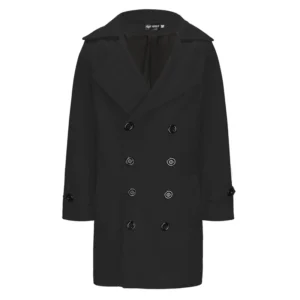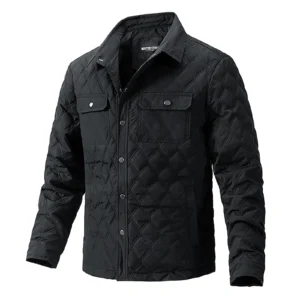Introduction: Understanding the Power of Proper Button Etiquette
The double-breasted coat stands as one of menswear’s most commanding garments. With its overlapping front panels and parallel rows of buttons, this classic piece makes a bold statement that speaks volumes about the wearer’s attention to style details. Unlike its single-breasted counterpart, the double-breasted coat demands a certain knowledge of buttoning etiquette that can elevate your entire look from merely dressed to impeccably styled.
Proper buttoning isn’t just about functionality—it fundamentally shapes how your coat drapes across your body, defines your silhouette, and projects your understanding of sartorial traditions. When buttons are fastened incorrectly, even the most expensive double-breasted coat can appear ill-fitting and awkward.
From royal family members to Hollywood legends like Humphrey Bogart and modern style icons, those who master the double-breasted coat understand that its power lies not just in its fabric or cut, but in how it’s worn—specifically, how it’s buttoned. An ultimate guide to men’s double-breasted coats reveals that these details make all the difference in achieving that perfect look.
Throughout this guide, we’ll explore everything from the basic anatomy of these distinguished garments to specific buttoning rules for various configurations, ensuring you’ll wear your men’s double-breasted overcoat with absolute confidence and precision.
The Fundamental Double-Breasted Coat Anatomy
Before mastering the art of buttoning, you need to understand the unique construction that sets double-breasted coats apart. Unlike single-breasted varieties, these coats feature two parallel rows of buttons with overlapping front panels, creating a distinctive look that adds visual heft and formality to your appearance.
The key components of a double-breasted coat include:
- Overlapping front panels: The right panel crosses over the left, creating the characteristic double-breasted look
- Button rows: Typically arranged in parallel vertical rows on the front
- Peaked lapels: Usually wider and more dramatic than those on single-breasted coats
- Button configuration: Described using a numerical system (e.g., 6×2, 4×2)
- Jigger/anchor button: The internal button that secures the underlying panel
The button configuration is particularly important to understand. When you see a description like “6×2,” the first number (6) refers to the total visible buttons on the front, while the second number (2) indicates how many of these buttons are functional or meant to be fastened. This configuration creates the classic double-breasted look most commonly associated with formal outerwear.
Understanding the differences between double-breasted vs. single-breasted coat styles helps appreciate why specific buttoning rules exist. The overlapping structure of double-breasted coats requires proper buttoning to maintain its intended shape and drape, whereas single-breasted coats tend to be more forgiving in their presentation.
The Golden Rules: Universal Principles for Every Double-Breasted Coat
Regardless of the specific style or button configuration of your double-breasted coat, certain universal principles apply to ensure proper presentation:
Always fasten the jigger button: This internal anchor button is essential for maintaining proper drape and preventing the overlapping panels from separating awkwardly. Even if you choose to leave external buttons undone for a casual look, the jigger button should remain fastened when wearing the coat.
Leave the bottom exterior button unfastened: Similar to single-breasted jackets, the bottom button on double-breasted coats should remain unfastened. This tradition dates back centuries and allows for better drape and movement while preventing the fabric from pulling awkwardly across your midsection.
Identify the primary functional buttons: Each double-breasted coat has specific buttons designed to be functional. These are usually positioned at waist level and create the ideal closure point for the garment. These primary buttons create the proper tension and shape when fastened.
Maintain visual symmetry: When buttoned, your double-breasted coat should present a balanced appearance. Misaligned buttoning creates asymmetry that undermines the coat’s elegant lines.
Use buttons to create the V-shape: Proper buttoning helps achieve the desirable V-shaped silhouette that makes double-breasted coats so flattering, defining the waist and broadening the chest and shoulders.
These principles exist for both practical and aesthetic reasons. They ensure comfort while sitting and moving, prevent fabric strain, and maintain the elegant lines that double-breasted coats are designed to create. The expert guide on double-breasted coat fit confirms that proper buttoning is just as important as proper sizing when it comes to presenting yourself well.
Configuration-Specific Buttoning Guide: The 6×2 Classic
The 6×2 configuration represents the quintessential double-breasted coat design. With six buttons arranged in two vertical rows (three buttons per row) and two functional fastening buttons, this classic style demands specific buttoning etiquette.
Here’s how to properly button a 6×2 double-breasted coat:
- Start by fastening the jigger button (the internal anchor button).
- Next, fasten the middle row button on the right side. This is your primary functional button and creates the main closure point at your natural waist.
- For formal occasions, you may also fasten the top right button, though this is optional and depends on personal preference and the specific cut of your coat.
- Always leave the bottom button unfastened, following traditional tailoring etiquette.
This buttoning approach creates the ideal silhouette: a clean, V-shaped front that emphasizes your chest and creates a defined waistline. The unfastened bottom button prevents the coat from pulling across your hips when you move or sit.
Many gentlemen who invest in quality wool overcoats choose the 6×2 configuration for its classic appeal and versatility. When properly buttoned, this style offers the perfect balance of formality and timeless elegance that makes double-breasted coats enduring favorites.
Configuration-Specific Buttoning Guide: The 4×2 Option
The 4×2 configuration offers a sleeker, more modern interpretation of the double-breasted coat. With four visible buttons arranged in two rows (two buttons per row) and two functional fastening points, this style presents a cleaner front while maintaining the distinctive double-breasted overlap.
For properly buttoning a 4×2 double-breasted coat:
- Always secure the internal jigger button first.
- Fasten the top row button on the right side. Unlike the 6×2 configuration, with 4×2 the top button typically serves as the primary fastening point.
- Leave the bottom row completely unfastened, following traditional coat etiquette.
The 4×2 configuration creates a higher buttoning point than the 6×2, which can elongate the lapel lines and create a slimming effect. This makes it particularly flattering for many body types and offers a slightly less formal appearance than its six-button counterpart.
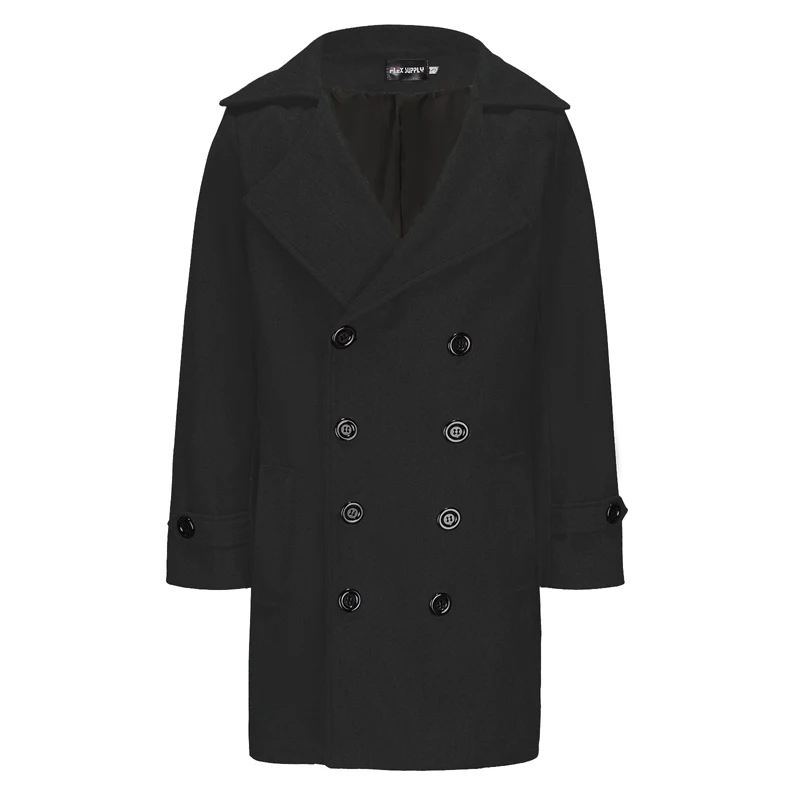
Understanding proper formal coat etiquette becomes particularly important with 4×2 configurations, as they often appear in business and semi-formal settings where presentation matters. The cleaner front makes this style increasingly popular for those seeking a modern take on traditional double-breasted elegance.
Configuration-Specific Buttoning Guide: 6×1 and 4×1
Less common but equally distinguished are the 6×1 and 4×1 configurations. These styles feature six or four visible buttons respectively, but with only one button designed to be fastened. This creates a unique look that bridges the gap between traditional double-breasted formality and more relaxed styling.
For a 6×1 double-breasted coat:
1. Secure the internal jigger button.
2. Fasten only the designated functional button, typically positioned at the middle or upper-middle of the right side.
3. Leave all other visible buttons unfastened.
For a 4×1 double-breasted coat:
1. Secure the internal jigger button.
2. Fasten only the single functional button, usually positioned at the upper right.
3. Leave all other buttons open.
These single-fastening configurations create a more relaxed drape while maintaining the distinctive overlapping panels of double-breasted design. The result is often a coat that moves more freely and creates a less rigid silhouette than traditional configurations.
The 6×1 and 4×1 styles are popular choices for men’s dress coats that bridge formal and casual occasions, offering versatility while maintaining the distinctive double-breasted profile. Their more relaxed nature makes them excellent options for those new to double-breasted styling.
Situational Buttoning Etiquette: Standing vs. Sitting
Proper double-breasted coat etiquette varies depending on whether you’re standing or sitting, with each position requiring different buttoning approaches to maintain both comfort and style.
When Standing:
– Keep your external buttons fastened according to your coat’s configuration (as detailed in previous sections)
– Maintain the jigger button closure for proper drape
– This creates the clean, tailored silhouette that double-breasted coats are designed to achieve
When Sitting:
– Unfasten the external buttons to prevent strain and pulling
– You may keep the jigger button fastened for ease when standing again
– This prevents the fabric from bunching awkwardly and protects the buttons from stress
The transition between these states should be handled smoothly. As you prepare to sit, unbutton your coat with a simple, fluid motion. When rising, refasten efficiently but without drawing undue attention to the process. With practice, this becomes second nature.
This dynamic approach to buttoning preserves your coat’s structure and prevents unnecessary stress on the fabric and buttons. The classic double-breasted coat guide emphasizes that proper care in these transitions helps maintain your garment’s shape and extends its lifespan while ensuring you always look composed.
Formal vs. Casual Contexts: Adapting Your Buttoning Approach
The formality of your occasion should influence how strictly you adhere to traditional buttoning rules, with more formal events demanding closer attention to proper etiquette.
For Formal Settings (Black Tie Events, Weddings, Business Formal):
– Adhere strictly to traditional buttoning rules
– Ensure perfect symmetry and alignment
– Maintain fastened buttons when standing (except the bottom button)
– The coat should create a clean, structured silhouette
For Business and Professional Settings:
– Follow standard buttoning conventions
– Maintain a polished appearance with properly fastened buttons
– Pay attention to proper unbuttoning when seated
– Project competence through attention to detail
For Casual Contexts:
– Some flexibility is permitted while maintaining good form
– You might leave the coat entirely unbuttoned for a relaxed look
– The jigger button may still be fastened to maintain some structure
– Personal style can play a larger role in your approach
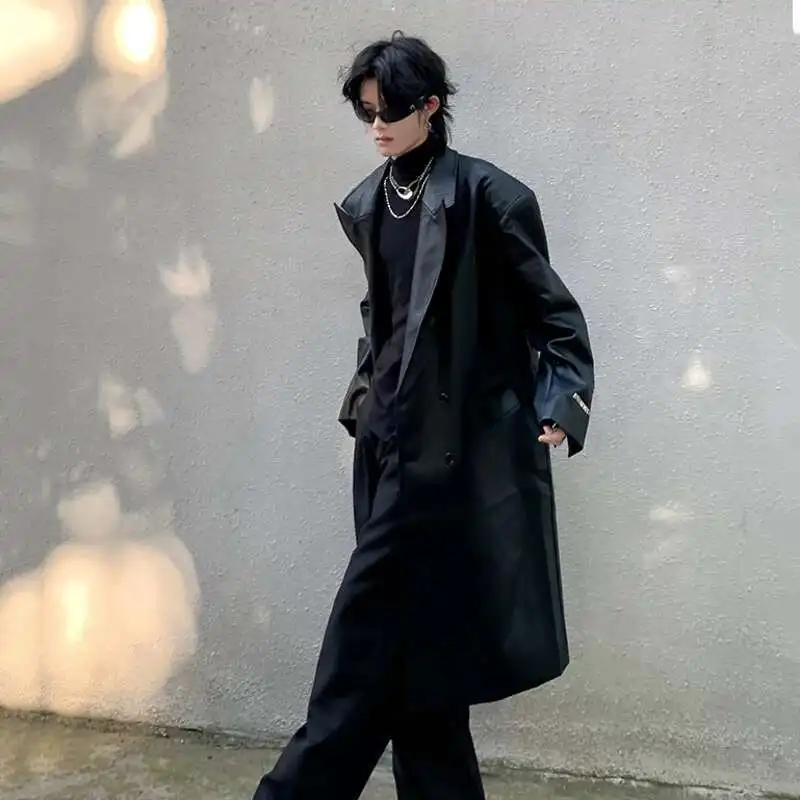
Military-inspired double-breasted coats, such as pea coats, often have their own buttoning traditions that reflect their naval heritage. These typically involve fastening all functional buttons for an authentic military appearance.
Learning to master formal double-breasted coats includes understanding these contextual variations, allowing you to adjust your presentation appropriately while always maintaining an air of intentional styling rather than careless oversight.
The Historical Context: Why These Rules Exist
The buttoning conventions for double-breasted coats aren’t arbitrary—they emerge from a rich historical tradition that blends practical function with evolving style standards.
Double-breasted coats trace their lineage directly to naval uniforms of the 18th and 19th centuries. Naval officers’ coats featured the overlapping front panels to provide extra warmth and protection against harsh sea conditions. The additional layer of fabric across the chest offered crucial insulation, while the multiple buttons ensured a secure closure against strong winds.
The practice of leaving the bottom button unfastened originated with military and riding traditions. As officers needed to ride horses comfortably, unbuttoned lower portions allowed for ease of movement in the saddle. This practical consideration gradually evolved into a style convention that persisted even after the functional need disappeared.
Throughout the early 20th century, as double-breasted suits and coats entered civilian fashion, these military traditions were maintained as markers of proper dressing. The Duke of Windsor (formerly King Edward VIII) popularized many such conventions, cementing them in modern menswear etiquette.
The double-breasted pea coat, with its distinctive naval heritage, remains one of the most direct connections to this military origin. Its traditional buttoning pattern reflects its functional roots while maintaining the stylish appearance that has made it a menswear staple.
Common Buttoning Mistakes to Avoid
Even stylish men can undermine their appearance by making these common double-breasted coat buttoning errors:
• Neglecting the jigger button: Failing to fasten this internal anchor causes the coat to hang awkwardly, with panels that separate unpredictably as you move. Always secure this first for a proper foundation.
• Fastening the bottom button: This creates unnecessary tension across the hips, causing the coat to pull and creating an unflattering silhouette. It also betrays a lack of understanding of classic tailoring conventions.
• Buttoning too many buttons: Creating an overly rigid, constrained appearance that looks stuffy rather than sophisticated. Stick to the functional buttons intended for closure.
• Leaving all buttons unfastened when standing: While acceptable in very casual settings, this typically looks sloppy and negates the structured elegance that makes men’s overcoats so distinguished.
• Creating button asymmetry: Misaligning buttons and buttonholes disrupts the clean lines of the coat. Take care to fasten buttons to their correct corresponding buttonholes.
• Keeping external buttons fastened when sitting: This causes strain on both the fabric and buttons while creating an uncomfortable, restrictive feeling. Always unfasten before sitting down.
Correcting these mistakes requires just a moment of attention but dramatically improves how your coat looks and feels. With practice, proper buttoning becomes instinctive, allowing you to wear your double-breasted coat with the confidence it deserves.
Expert Tips for Perfect Double-Breasted Presentation
Beyond the basic rules, these expert insights will help you achieve the most flattering presentation of your double-breasted coat:
Start with proper fit: No buttoning technique can compensate for a poorly fitted coat. Ensure the shoulders align with your natural shoulder line and the waist suppression complements your body shape.
Pay attention to button stance: The position of the buttons significantly affects your visual proportions. Higher-placed buttons elongate the lapel line, while lower buttons can shorten the torso. Choose accordingly based on your height and build.
Adapt to your body type: Broader men may benefit from keeping the top button unfastened to avoid a constrained appearance, while slimmer men might fasten both primary buttons for more definition.
Consider button materials: Horn, mother-of-pearl, and metal buttons each make different statements about formality. Ensure your buttoning style complements these material choices.
Invest in proper tailoring: A skilled tailor can adjust button placement to optimize your coat’s drape and proportion, ensuring the most flattering presentation for your specific build.
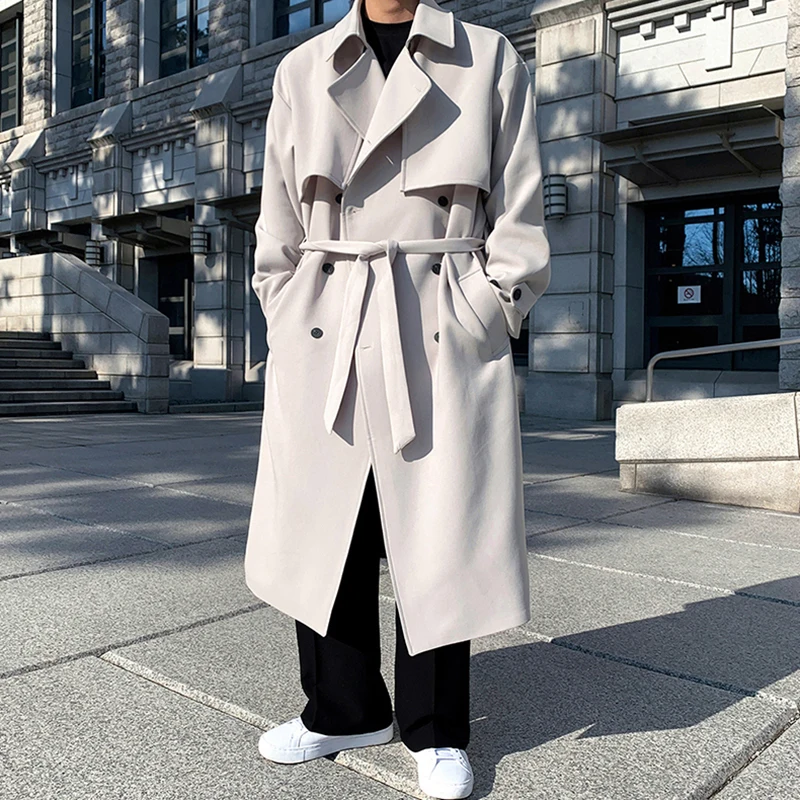
Knowing how to style a double-breasted coat properly transforms it from merely an outer layer into a sophisticated style statement. Small adjustments in how you fasten and present your coat can dramatically enhance its appearance.
Mens Double Breasted Pea Coat, Mens Wool Blend Coat, Mens Wool Pea Coat
Price range: $136.84 through $157.36 Select options This product has multiple variants. The options may be chosen on the product pageMens Cashmere Overcoat, Mens Hooded Winter Coat, Mens Wool Blend Coat
Price range: $128.72 through $139.68 Select options This product has multiple variants. The options may be chosen on the product pageMens Black Overcoat, Mens Black Wool Coat, Mens Wool Overcoat
$339.18 Select options This product has multiple variants. The options may be chosen on the product pageMens Double Breasted Pea Coat, Mens Hooded Winter Coat, Mens Quilted Coat
Price range: $81.00 through $108.48 Select options This product has multiple variants. The options may be chosen on the product pageMens Grey Overcoat, Mens Wool Blend Coat, Mens Wool Overcoat
$201.28 Select options This product has multiple variants. The options may be chosen on the product pageMens Herringbone Coat, Mens Long Overcoat, Mens Wool Overcoat
Price range: $197.16 through $203.69 Select options This product has multiple variants. The options may be chosen on the product page
Frequently Asked Questions About Double-Breasted Buttoning
Q: Is it ever acceptable to button the bottom button?
A: Generally no. Traditional tailoring etiquette dictates leaving the bottom button unfastened on double-breasted coats. This convention enhances comfort and preserves the proper drape of the garment.
Q: What if my double-breasted coat only has four buttons total?
A: For a 4-button coat (typically a 4×1 configuration), you would fasten only the designated functional button, usually the top button on the right side, while leaving the others unfastened.
Q: Should the coat always be buttoned when standing?
A: In formal and business settings, yes. For casual contexts, you have more flexibility, though a properly buttoned coat generally presents a more polished appearance. The internal jigger button should remain fastened even if you choose to leave the external buttons open.
Q: How can I tell which buttons are meant to be functional?
A: Functional buttons are typically positioned at or slightly above your natural waist. On most well-designed double-breasted coats, these buttons will align naturally when the coat is worn properly. When in doubt, consult the advantages of double-breasted coats for specific guidance on your coat style.
Q: Do vintage double-breasted coats follow different rules?
A: Vintage coats sometimes feature different button configurations based on the era’s fashion standards. However, the fundamental principles remain similar—avoid buttoning the bottom button and prioritize a clean drape over excessive buttoning.
Caring for Your Double-Breasted Coat Buttons
Proper buttoning habits extend beyond mere appearance—they directly impact the longevity of your coat and its buttons. Taking care of these details preserves both function and form.
Always unfasten all buttons before removing your coat to prevent unnecessary strain. Tugging a buttoned coat off your shoulders puts extreme pressure on buttons and can damage both the buttons themselves and the surrounding fabric.
Check button security regularly. Double-breasted coats undergo more button stress than single-breasted versions due to the overlapping panels. Loose buttons should be reinforced promptly to prevent loss. Metro Cloak recommends keeping spare buttons if your coat included them.
When storing your double-breasted coat, fasten the jigger button but leave external buttons unfastened to maintain the proper shape without creating pressure points. Always use proper-width hangers to support the shoulders correctly.
For button repairs, seek professional help rather than attempting DIY fixes. Proper placement affects the entire drape of the coat, making this a detail best left to experienced tailors who understand the men’s coat length and style guidelines that influence proper presentation.
When and How to Break the Rules with Style
While understanding traditional buttoning rules provides a foundation, true style sometimes involves knowing when to bend these conventions. The Italian concept of “sprezzatura”—a studied nonchalance—sometimes applies to double-breasted coat styling.
For a deliberately casual approach, you might leave all external buttons unfastened while securing only the jigger button. This creates a flowing, relaxed appearance that works well in creative or casual environments. The key is making this look intentional rather than forgetful.
Some style enthusiasts occasionally button only the bottom button, deliberately breaking convention to create a unique silhouette. This requires confidence and should be approached as a conscious style choice rather than a regular practice.
Whatever rule-breaking you attempt, remember that understanding the rules must come first. True style innovators know exactly which conventions they’re challenging and do so with purpose.
The long overcoat styles in double-breasted configurations often provide the most dramatic canvas for such style experiments, with their greater expanse of fabric allowing for more visible impact from buttoning choices.
Conclusion: Confidence Through Buttoning Mastery
Mastering the art of properly buttoning your double-breasted coat transforms a simple act into a statement of sartorial knowledge. The rules we’ve explored—from always securing the jigger button to leaving the bottom button unfastened, from adapting to different configurations to adjusting for formal and casual contexts—serve as the foundation for confidently wearing this distinguished garment.
These principles aren’t about rigid adherence to arbitrary rules but about understanding how proper buttoning enhances the coat’s designed silhouette and your overall presentation. When you button your double-breasted coat correctly, you honor both the garment’s heritage and the craftsmanship that went into creating it.
As you apply these guidelines, you’ll develop an intuitive sense for how your specific coat should be worn. This knowledge allows you to move beyond mere correctness into the realm of personal style, where you can appreciate the definitive guide to double-breasted overcoat styles and make choices that best flatter your build and express your personality.
The double-breasted coat, when properly buttoned and worn with confidence, remains one of menswear’s most powerful statements—a perfect blend of tradition, elegance, and commanding presence.


